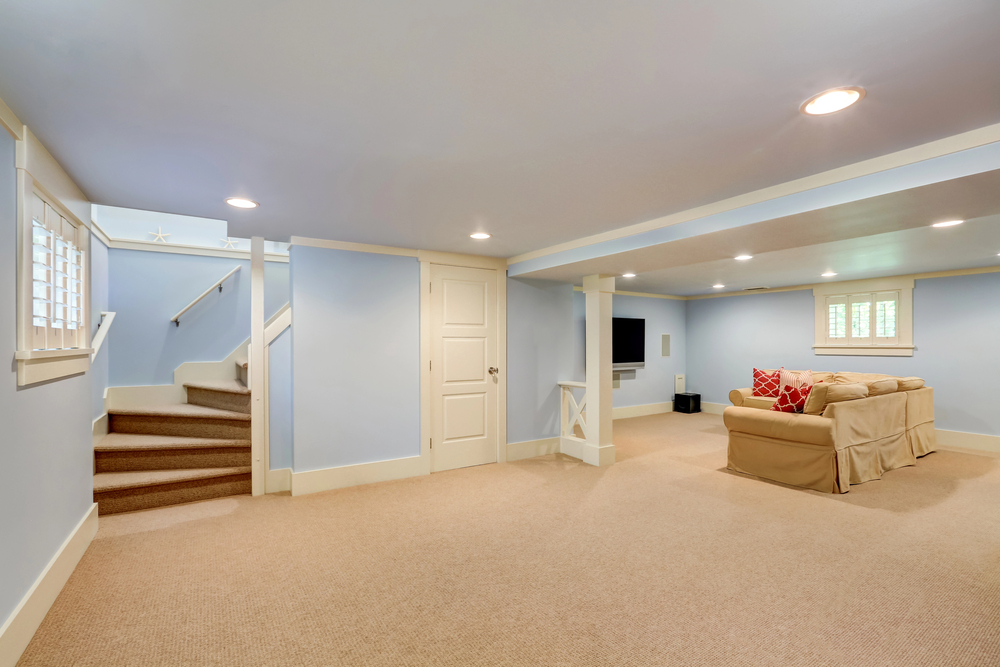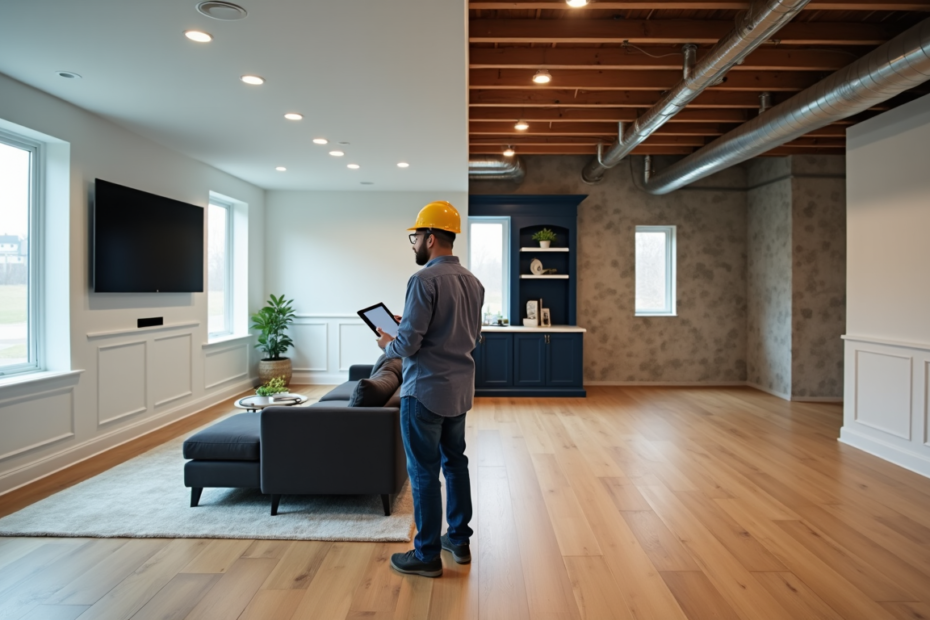Basement finishing ranks as one of the smartest home improvement investments available today, with an impressive 80-90% return on investment. The National Association of Realtors and the National Association of the Remodeling Industry consistently place this renovation among the top four interior remodels that retain their value.
The COVID-19 pandemic sparked a 17% rise in basement remodel projects, reflecting a clear change in buyer priorities. Adding features like a guest suite can increase your property value by up to 12%, especially when you have a thriving short-term rental market nearby. Your basement investment cost starts at $57,500 to convert half an unfinished basement into a living space, but the added home value makes it worthwhile.
This piece will show you the basement finishing strategies that work to boost your home’s market value. Our recommendations come from solid real estate data and current market trends.
Understanding Basement Value Potential
Appraisers look beyond simple square footage calculations to evaluate a basement’s true value. A finished basement adds about 50% to 60% of the above-grade square footage value to your home’s total worth. All the same, your actual return on investment depends on several important factors.
Current basement value calculation
The financial effect of finishing a basement shows a clear pattern in the real estate market. Homeowners typically get back 70% to 75% of their investment at sale time. To cite an instance, a USD 10,000 improvement project could boost your property value by about USD 7,000. The Pacific area shows even better numbers, with returns reaching 86% ROI.
Market analysis
Buyer priorities have changed since the pandemic. People just need homes with versatile basement spaces now. Buyers are looking for dedicated areas they can turn into home offices, gyms, and remote learning spaces. Location makes a big difference too – urban areas where space costs more tend to value finished basements higher.
Property type considerations
Your basement’s style plays a big role in its value potential:
- Walk-out basements: These top the value chart among all types because they offer above-grade features and natural light
- Garden-level basements: Worth more than full basements thanks to partial above-grade exposure
- Standard basements: Give moderate returns between walk-out and garden-level options
Experts suggest keeping renovation costs between 10-15% of your home’s current value to maximize returns. On top of that, it pays to choose the right finishes – modest but reliable materials often beat luxury upgrades in most markets.
Open-concept designs attract more buyers than multiple small rooms. Quality flooring, good lighting, and design elements that match your upper floors will give a big boost to your basement’s value.
Real estate agents and interior designers can help you understand local market priorities and potential returns before you start renovations. This smart approach will line up your basement project with current market needs and long-term value goals.

High-ROI Basement Features
Smart basement renovations that turn unused space into valuable living areas need good planning and a focus on features with high returns. Market analysis shows some basement upgrades give better ROI than others.
Extra bedroom addition
A basement bedroom stands out as your best renovation choice and can give you up to 70% ROI at resale. But to make it a legal bedroom, your space needs these requirements:
- Minimum 70 square feet with 7-foot-high ceilings
- Adequate heating and ventilation systems
- Two forms of egress for safety
- Proper moisture-resistant materials and finishes
You’ll get the best value when you use light, neutral colors and install recessed lighting on dimmers to create a welcoming feel. Basements with direct yard access offer even better potential, especially if you’re thinking about Airbnb or rental options.
Home office setup
Home offices are in high demand now, and real estate agents say it’s the top feature buyers look for. Your basement office should have:
- Built-in storage cabinets
- Professional backdrop for video calls
- Direct access door for business clients
- Ample lighting solutions
Entertainment space design
A versatile entertainment area boosts your home’s appeal by a lot. The best entertainment spaces include:
- Open-concept layout for maximum flexibility
- Wet bar installation ($2,000-12,000 investment range)
- Media room with integrated audio-visual systems
- Game area for varied activities
Adding a powder room to your basement entertainment space makes it more functional and valuable. To get the best ROI, stick to mid-range finishes instead of luxury upgrades – research shows most buyers are happy with quality basics.
Smart planning of these high-return features helps homeowners get back about 86% of their basement finishing investment. Success comes from creating multipurpose spaces that appeal to future buyers.
Smart Planning for Maximum Value
Smart planning and financial decisions pave the way for successful basement finishing projects. A complete plan will add maximum value and help avoid surprise expenses.
Pre-renovation assessment
You need to tackle basic problems first. Start by looking for moisture issues, since waterproofing typically costs around USD 4,500. Next, check your foundation for cracks or shifts that might need an engineer’s expert opinion.
Your pre-renovation checklist should have:
- Building code rules and permit requirements
- Current utility spots and access points
- Ceiling height limits and structural constraints
- Possible egress window spots
- Air flow and humidity control system status
Budget optimization strategies
A realistic budget balances costs with returns. Experts say you should set aside 10-15% of your home’s value for basement finishing. Here are proven ways to get the best return on investment:
Smart timing is vital – you’ll find better rates from contractors and discounts on materials during slow seasons. Getting quotes from several contractors helps you find competitive prices without sacrificing quality work.
Sort out your “must-haves” from “nice-to-haves” when you start planning. This helps you focus your money on essential items first. You can add extra features later if your budget allows.
Experts suggest keeping 10-20% extra for unexpected problems. You should spend most of your money on things that boost home value directly, like good waterproofing and structural upgrades.
Affordable approaches include:
- Getting prices from multiple suppliers
- Doing some work yourself when possible
- Using existing materials where you can
- Creating layouts that need fewer structural changes
Your main goal should be creating useful, attractive spaces without breaking the bank. Good planning and careful money management will help improve your home’s value while staying within budget.

Essential Quality Standards
Building codes and quality standards are the foundations of a successful basement finishing project. A good grasp of these requirements will give you both safety and long-term value for your investment.
Building code requirements
Local building regulations set specific standards for basement finishing projects. Most cities need a minimum ceiling height of 6’8″ for non-habitable spaces and 7′ for habitable areas. Good ventilation is a must – window openings should equal 4% of the floor area or you’ll need a mechanical ventilation system that can provide 0.35 air exchanges per hour.
Your safety features must have smoke alarms in every sleeping room and carbon monoxide detectors on each floor level. The electrical code says you need outlets every 12 feet on walls wider than 24 inches, among other requirements like GFCI protection in bathrooms and above countertops.
Professional vs DIY considerations
DIY basement finishing might look budget-friendly at first, but professional contractors bring clear benefits. Licensed contractors know local building codes, take care of permit applications, and make sure everything meets safety regulations. They also have proper insurance coverage and the expertise needed for complex tasks.
DIY projects can work out well with good planning. However, you should always leave electrical work, plumbing, and structural changes to certified professionals. Taking these on without proper know-how can get pricey and create safety risks.
Inspection checklist
The finishing process needs these key inspections:
- Underslab plumbing checks before floor replacement
- Rough-in examination before covering walls and ceilings
- Insulation check before drywall installation
- Final inspection when the project’s done
Your inspector will look at R-18 insulation in foundation walls, treated bottom plates for basement walls, and proper landing sizes at stairway bottoms. Mechanical rooms need at least 40 square feet, plus proper ventilation for furnaces and water heaters.
Getting the right permits helps with accurate property value assessment and keeps you in line with local regulations. Regular moisture tests and foundation checks throughout the project help prevent future problems.
Conclusion
Basement finishing proves to be a reliable way to boost property value, especially as today’s market favors multipurpose living spaces. Our research shows thoughtful basement renovations deliver strong returns when they focus on features like home offices and entertainment areas that buyers want.
A well-planned renovation substantially increases your home’s value compared to an average project. Your investment stays protected when you follow building codes, hire qualified professionals, and maintain quality standards. The best returns come from keeping renovation costs between 10-15% of your home’s value and creating versatile designs.
Local market priorities and building requirements need careful thought before starting a basement project. The original investment might look high, but an 80-90% return makes sense to homeowners who want to improve their property value. Quality workmanship and proper moisture control will keep your finished basement a valuable asset for years.
